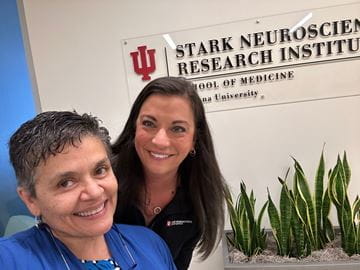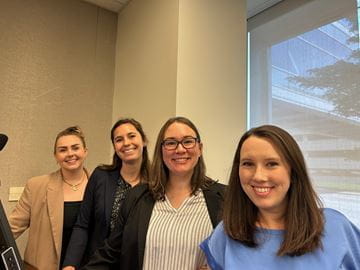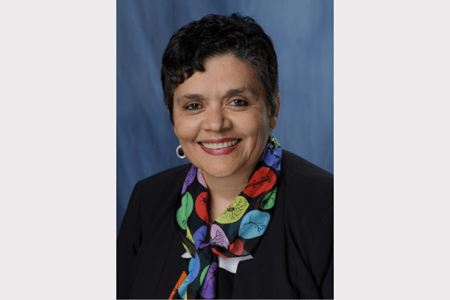Malú Tansey, PhD and her team of researchers like to think “outside the brain.”
Her lab investigates the role of inflammation and immune system responses on brain health and the development of neurodegenerative diseases, such as Alzheimer’s disease, Parkinson’s disease and frontal temporal dementia, with a specific focus on the gut-brain connection.
“To think outside the brain is our way to think outside the box,” Tansey said. “We’re very interested in that crosstalk between the brain and peripheral organs, the brain and peripheral blood, and how important that communication is for brain health.”
Ultimately, Tansey is interested in figuring out how to harness the power of the immune system to identify and diagnosis neurodegenerative disorders earlier so clinicians can intervene with better therapies to prevent or delay these devastating diseases that affect millions of people.
In January 2025, Tansey will move her lab from the University of Florida College of Medicine to the Indiana University School of Medicine. She will be named the James A. Caplin, MD Chair in Alzheimer’s Research and a Professor in the Department of Neurology.
“There has been significant and sustained growth in research in neurodegenerative disorders at IU School of Medicine and in the Department of Neurology specifically,” said Laurie Gutmann, MD, chair of the Department of Neurology. “Dr. Tansey brings an important new strength to the ongoing research here, with a focus on the immunology of neurodegenerative diseases including Alzheimer’s disease and Parkinson’s disease. She also has strengths in translating research findings from the bench to the patient, adding to our strong clinical research program.”
Tansey, who will take on the roles of Director of the Neuroimmunology Research Group and Executive Associate Director of Education at Stark Neurosciences Research Institute, said joining IU School of Medicine will take her team “to the next stage of growth” in their careers.
“Dr. Tansey brings an incredible spirit to IU School of Medicine of collaboration and a strong background in mentoring and developing the next generation of neuroscientists,” said Bruce Lamb, PhD, executive director of Stark Neurosciences Research Institute. “We are fortunate to have her lead a new research group studying neuroimmunology and contribute to our comprehensive research programs in Alzheimer’s disease and neurodegenerative disorders.”

Collaboration at IU
Ever since Lamb began as the executive director of Stark Neurosciences Research Institute in 2016, Tansey said she’s closely followed the institute’s growth and development as a major contributor to the field of neuroscience research. Primary members of the neuroscience research institute collectively received nearly $98.5 million in National Institutes of Health funding in 2023, more than quadrupling their $22.4 million NIH funding amount in 2016.
Tansey said she routinely connects with IU School of Medicine faculty at scientific conferences and enjoys reading the positive and uplifting social media posts from Lamb on X (formerly Twitter), where he regularly promotes the research institute using the hashtag #goteamstark.
“I've been really impressed with their caliber of science and their attention to the next generation of investigators,” Tansey said about Stark Neurosciences Research Institute. “They really have a wonderful team-science mentality. And that's what you really need to accelerate discoveries. I think the days of doing your own thing in your own lab are gone, and we really need to have more multidisciplinary collaboration in an institution and across institutions.”
Tansey, when she begins in 2025, will lead a new research interest group at Stark Neurosciences Research Institute focused on neuroimmunology. The institute, composed of over 100 researchers across the IU School of Medicine, including the Fort Wayne, Muncie, and Terre Haute regional campuses, and IU Indianapolis and IU Bloomington, currently has nine research groups, from pain and addiction to stem cell and advanced imaging.
In collaboration with the Brown Center for Immunotherapy in the IU Melvin and Bren Simon Comprehensive Cancer Center at the IU School of Medicine, Tansey said she plans to work with immunologists researching how to harness the power of the body’s immune system to treat cancer and collectively investigate challenging brain cancers like glioblastoma multiforme. Research at the Brown Center focuses on multiple myeloma and triple negative breast cancer, two conditions notoriously resistant to standard treatments.
"You look at their success and you kind of wonder: If we know the immune system and that inflammation plays a role in risk and progression of age-related neurodegenerative diseases, why couldn't we take a page out of their playbook, work with them and figure out how to diagnose neurodegenerative diseases earlier, intervene with immunomodulatory treatments and recruit people for clinical trials based on clues from their immune system,” Tansey said.
 The IU School of Medicine’s comprehensive Alzheimer’s disease research program also drew Tansey to the university. The school is ranked No. 6 in the nation for National Institute of Aging funded research and received $87 million from the NIH to fund Alzheimer's disease research.
The IU School of Medicine’s comprehensive Alzheimer’s disease research program also drew Tansey to the university. The school is ranked No. 6 in the nation for National Institute of Aging funded research and received $87 million from the NIH to fund Alzheimer's disease research.
Tansey said she’s excited to collaborate with neurodegeneration researchers at IU School of Medicine like Donna Wilcock, PhD, who focuses on vascular contributions to cognitive impairment and dementia; the research team in the Model Organism Development and Evaluation for Late-Onset Alzheimer’s Disease (MODEL-AD) consortium, which develops new models of Alzheimer’s disease and tests therapeutics; Jungsu Kim, PhD, who works on brain lipid-regulating proteins in microglia, the brain’s immune cells; and Lamb and Gary Landreth, PhD, who are researching Alzheimer’s risk genes that are highly expressed in immune cells.
Tansey and Wilcock are two neurodegeneration researchers who will operate their labs in the new Medical Education and Research Building at the IU School of Medicine, an 11-floor, 326,000 square-foot building being constructed south of the Neuroscience Research Building at 16th Street and Senate Avenue. The Brown Center will also move to the new building, incorporating greater collaboration. The $230 million building is slated to open in summer 2025.
The gut-brain connection
Over the past few years, Tansey and her lab team have been investigating the connection between the brain and the gut microbiome, studying how and what signals are being sent from the gut to the brain and what cells may affect neurodegenerative and autoimmune diseases.
"We've been very interested in the gut microbiome itself as a regulator of this crosstalk with the brain,” Tansey said. “We know that there are microbial-derived substances and peptides that can affect microglial function, we also know that there are certain T cells that get licensed or differentiated in the gut and then they travel to the brain and/or the cytokines they produce act on the brain."
Those T cells — a type of white blood cell that fights against infection and disease in the body — have been detected in Parkinson’s disease and Alzheimer’s disease brains as well as in autoimmune diseases like multiple sclerosis. The researchers are investigating whether there’s an imbalance in the microbiome in Alzheimer’s disease and Parkinson’s that disrupts this connection between the brain and the microbiome that compromises brain health.
In addition to investigations into Alzheimer’s disease and Parkinson’s disease, Tansey has also led research into inflammation pertaining to depression, autism spectrum disorder and frontal temporal dementia (FTD).
Story of a Latina researcher
Growing up on the border of the United States and Mexico in Texas, Tansey’s Mexican American heritage strongly influences her research and mission as an educator.
Much of Tansey’s research is translational, from bench to bedside. When a clinical trial is recruiting participants, Tansey said representation is key to good science. When researchers are evaluating new drugs or treatments, they need people from underrepresented groups, like Hispanic and Black communities, to improve the data and make the trial equitable.
“I think within the context of research, there are a lot of disparities — not just access to health care — but also how different people from ethnic groups respond to these diseases,” Tansey said. “We need to consider their ethnicity and their genetics.”
 As the Senior Director of Graduate Studies for the Emory Neuroscience Graduate Program at Emory University in Atlanta from 2009-2019, Tansey attracted and retained learners from underrepresented groups to the program. She’s also served as a mentor to undergraduate, graduate and post-graduate trainees, many of them women from underrepresented groups.
As the Senior Director of Graduate Studies for the Emory Neuroscience Graduate Program at Emory University in Atlanta from 2009-2019, Tansey attracted and retained learners from underrepresented groups to the program. She’s also served as a mentor to undergraduate, graduate and post-graduate trainees, many of them women from underrepresented groups.
Tansey, whose new lab at IU School of Medicine will initially be composed of six other female researchers, said working in science can be especially difficult for women and women of color. They must be extra flexible and adaptable to incorporate career with family and often elderly parents and develop strong networks and friendships that will sustain them throughout life, she said. Tansey desires to encourage early career researchers as they navigate the complexities and barriers that exist within science.
"I'm working to continue to be a role model to these scientists, and I would love to continue to do that as I move to Indiana,” Tansey said. “We must acknowledge that the rich multicultural fabric of our nation needs to be reflected in our scientific workforce. It's important for other women and groups from underrepresented ethnic groups to understand the challenges that we face and that they're going to face so they can contribute to creative solutions.”
